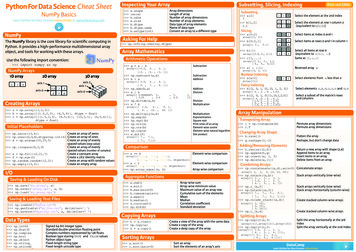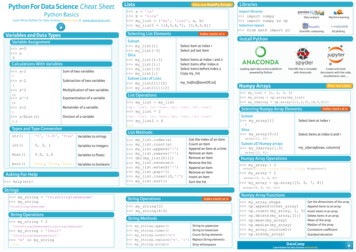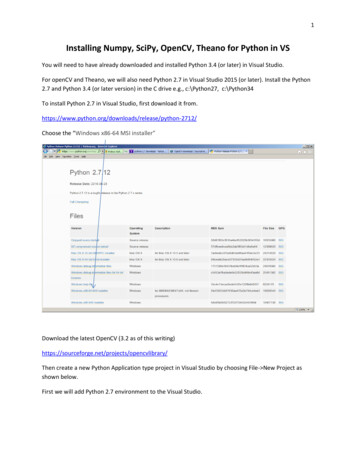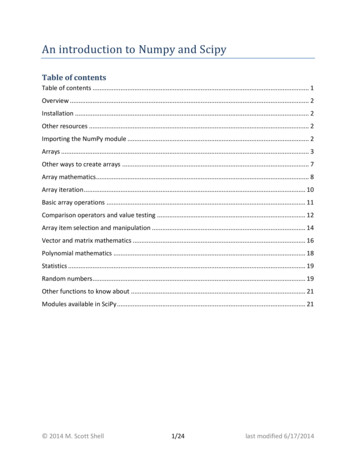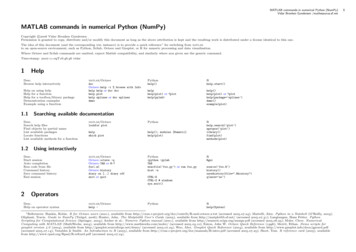
Transcription
CS229Python & NumpyJingbo Yang, Zhihan Xiong
How is python related to with others?Python 2.0 released in 2000(Python 2.7 “end-of-life” in 2020)Python 3.0 released in 2008(Python 3.6 for CS 229)Can run interpreted, like 8941g001 fig1 260447599
Before you startUse AnacondaCreate a new environment (full Conda)conda create -n cs229Create an environment (Miniconda)conda env create -f environment.ymlActivate an environment after creationconda activate cs229
Notepad is not your friend Get a text editor/IDE PyCharm (IDE) Visual Studio Code (IDE?) Sublime Text (IDE?) Notepad /gedit Vim (for Linux)
To make you more preparedPyCharm Great debugger Proper projectmanagementFYI, professional version free for students: https://www.jetbrains.com/student/
To make you more preparedVisual Studio Code Light weight Wide variety of plugins to enable support forall languagesBetter UI
Basic Python
String ('I love CS229. (upper)'.upper())print('I love CS229. (rjust 20)'.rjust(20))print('we love CS229. (capitalize)'.capitalize())print('I love CS229. (strip)'.strip())print('I like ' str(cs class code) ' a lot!')print(f'{print} (print a function)')print(f'{type(229)} (print a type)')print('Old school formatting: {.2F}'.format(1.358))
ListList creationlist 1 ['one', 'two', 'three’]list 1.append(4)list 1.insert(0, 'ZERO’)Insertion/extensionlist 2 [1, 2, 3]list 1.extend(list 2)List comprehensionlong list [i for i in range(9)]long long list [(i, j) for i in range(3)for j in range(5)]long list list [[i for i in range(3)]for in range(5)]sorted(random list)Sortingrandom list 2 [(3, 'z'), (12, 'r'), (6, 'e’),(8, 'c'), (2, 'g')]sorted(random list 2, key lambda x: x[1])
Dictionary and SetSet(unordered, unique)my set {i ** 2 for i in range(10)}Dictionary(mapping)my dict {(5 - i): i ** 2 for i in range(10)}Dictionary updatesecond dict {'a': 10, 'b': 11}my dict.update(second dict)Iterate through items{0, 1, 64, 4, 36, 9, 16, 49, 81, 25}{5: 0, 4: 1, 3: 4, 2: 9, 1: 16, 0: 25, -1: 36,-2: 49, -3: 64, -4: 81}dict keys([5, 4, 3, 2, 1, 0, -1, -2, -3, -4])for k, it in my dict.items():print(k, it)
Numpy
What is Numpy and why?Numpy – package for vector and matrix manipulationBroadcasting and vectorization saves time and amount of codeFYI, if you are interested in how/why vectorization is faster, checkout the followingtopics (completely optional, definitely not within scope)AVX instruction set (SIMD) and structure of x86 and RISCOpenMP and CUDA for multiprocessingAssembly-level optimization, memory stride, caching, etc.Or even about memory management, virtualizationMore bare metalFPGA, TPU
Convenient math functions, read before use!Python CommandDescriptionnp.linalg.invInverse of matrix (numpy as equivalent)np.linalg.eigGet eigen value (Read documentation on eigh and numpy equivalent)np.matmulMatrix multiplynp.zerosCreate a matrix filled with zeros (Read on np.ones)np.arangeStart, stop, step size (Read on np.linspace)np.identityCreate an identity matrixnp.vstackVertically stack 2 arrays (Read on np.hstack)
Your friend for debuggingPython CommandDescriptionarray.shapeGet shape of numpy arrayarray.dtypeCheck data type of array (for precision, for weird behavior)type(stuff)Get type of a variableimport pdb; pdb.set trace()Set a breakpoint f’My name is {name}’)Easy way to construct a message
Basic Numpy usageInitialization from Python listsarray 1d np.array([1, 2, 3, 4])array 1by4 np.array([[1, 2, 3, 4]])large array np.array([i for i in range(400)])large array large array.reshape((20, 20))Lists with different types(Numpy auto-casts to higherprecision, but it should bereasonably consistent)Numpy supports many typesof algebra on an entire arrayfrom list np.array([1, 2, 3])from list 2d np.array([[1, 2, 3.0], [4, 5, 6]])from list bad type np.array([1, 2, 3, 'a'])print(f'Data type of integer is {from list.dtype}')print(f'Data type of float is {from list 2d.dtype}')array 1 5array 1 * 5np.sqrt(array 1)np.power(array 1, 2)np.exp(array 1)np.log(array 1)
Dot product and matrix multiplicationA few ways to write dotproductarray 1 @ array 2array 1.dot(array 2)np.dot(array 1, array 2)Matrix multiplication like Axweight matrix np.array([1, 2, 3, 4]).reshape(2, 2)sample np.array([[50, 60]]).Tnp.matmul(weight matrix, sample)2D matrix multiplicationmat1 np.array([[1, 2], [3, 4]])mat2 np.array([[5, 6], [7, 8]])np.matmul(mat1, mat2)Element-wise multiplicationa np.array([i for i in range(10)]).reshape(2, 5)a * anp.multiply(a, a)np.multiply(a, 10)
BroadcastingNumpy compares dimensions of operands, then infers missing/mismatcheddimensions so the operation is still valid. Be careful with DIMENSIONSop1 np.array([i for i in range(9)]).reshape(3, 3)op2 np.array([[1, 2, 3]])op3 np.array([1, 2, 3])# Notice that the results here are DIFFERENT!pp.pprint(op1 op2)pp.pprint(op1 op2.T)# Notice that the results here are THE SAME!pp.pprint(op1 op3)pp.pprint(op1 op3.T)array([[ 1, 3, 5],[ 4, 6, 8],[ 7, 9, 11]])array([[ 1, 2, 3],[ 5, 6, 7],[ 9, 10, 11]])array([[ 1, 3, 5],[ 4, 6, 8],[ 7, 9, 11]])array([[ 1, 3, 5],[ 4, 6, 8],[ 7, 9, 11]])
Broadcasting for pairwise distancesamples np.random.random((15, 5))# Without broadcastingexpanded1 np.expand dims(samples, axis 1)tile1 np.tile(expanded1, (1, samples.shape[0], 1))expanded2 np.expand dims(samples, axis 0)tile2 np.tile(expanded2, (samples.shape[0], 1 ,1))diff tile2 - tile1distances np.linalg.norm(diff, axis -1)Both achieve the effect of# With broadcastingdiff samples[: ,np.newaxis, :]- samples[np.newaxis, :, :]distances np.linalg.norm(diff, axis -1)# With scipy (another math toolbox)import scipydistances scipy.spatial.distance.cdist(samples, samples)
Why should I vectorize my code?Shorter code, faster executiona np.random.random(500000)b np.random.random(500000)With loopdot 0.0for i in range(len(a)):dot a[i] * b[i]Numpy dot t)Wall time: 345msWall time: 2.9ms
An example with pairwise distanceSpeed up depends on setup and nature of computationsamples np.random.random((100, 5))With looptotal dist []for s1 in samples:for s2 in samples:d np.linalg.norm(s1 - s2)total dist.append(d)Numpy with broadcastingdiff samples[: ,np.newaxis, :] samples[np.newaxis, :, :]distances np.linalg.norm(diff, axis -1)avg dist np.mean(distances)avg dist np.mean(total dist)Wall time: 162ms(imagine without Numpy norm)Wall time: 3.5ms
Plotting
Other Python packages/toolsJupyter Notebook Interactive, re-execution, result storageMatplotlib Visualization (line, scatter, bar, imagesand even interactive 3D)Pandas (https://pandas.pydata.org/) Dataframe (database/Excel-like) Easy filtering, aggregation (also plotting, but fewpeople uses Pandas for plotting)
Example mlImportimport matplotlibimport matplotlib.pyplot as pltimport numpy as npCreate data# Data for plottingt np.arange(0.0, 2.0, 0.01)s 1 np.sin(2 * np.pi * t)Plottingfig, ax plt.subplots()ax.plot(t, s)Format plotax.set(xlabel 'time (s)', ylabel 'voltage (mV)',title 'About as simple as it gets, t.show()
Plot with dash lines and legendimport numpy as npimport matplotlib.pyplot as pltx np.linspace(0, 10, 500)y np.sin(x)fig, ax plt.subplots()line1, ax.plot(x, y, label 'Using set dashes()')# 2pt line, 2pt break, 10pt line, 2pt breakline1.set dashes([2, 2, 10, 2])line2, ax.plot(x, y - 0.2, dashes [6, 2],label 'Using the dashes parameter')ax.legend()plt.show()
Using subplotx np.arange(0, 3 * np.pi, 0.1)y sin np.sin(x)y cos np.cos(x)# Setup grid with height 2 and col 1.# Plot the 1st subplotplt.subplot(2, 1, 1)plt.grid()plt.plot(x, y sin)plt.title('Sine Wave')# Now plot on the 2nd subplotplt.subplot(2, 1, 2)plt.plot(x, y cos)plt.title('Cosine Wave')plt.grid()plt.tight layout()
Plot area under curve
Confusion matrixhttps://scikit-learn.org/stable/auto examples/model selection/plot confusion matrix.htmlfig, ax plt.subplots()im ax.imshow(cm, interpolation 'nearest', cmap cmap)ax.figure.colorbar(im, ax ax)# We want to show all ticks.ax.set(xticks np.arange(cm.shape[1]),yticks np.arange(cm.shape[0]),xticklabels classes, yticklabels classes,ylabel 'True label', xlabel 'Predicted label’,title title)# Rotate the tick labels and set their alignment.plt.setp(ax.get xticklabels(), rotation 45, ha 'right',rotation mode 'anchor')# Loop over data dimensions and create text annotations.fmt '.2f' if normalize else 'd'thresh cm.max() / 2.for i in range(cm.shape[0]):for j in range(cm.shape[1]):ax.text(j, i, format(cm[i, j], fmt),ha 'center', va 'center',color "white" if cm[i, j] thresh else "black")fig.tight layout()
Good luck on yourHW/Project!Questions?
LinksCS 231N Python Tutorial
Additional slides incase of Q&A
Where does my program start?It just worksA functionProperly
What is a class?Initialize the class toget an instance usingsome parametersInstance variableDoes somethingwith the instance
To use a classInstantiate a class,get an instanceCall an instance method
String manipulationFormattingstripped ' I love CS229! '.strip()upper case 'i love cs 229! '.upper()capitalized 'i love cs 229! '.capitalize()Concatenationjoined ‘string 1’ ‘ ’ ‘string 2'Formattingformatted ‘Formatted number {.2F}’.format(1.2345)
Basic data structuresListexample list [1, 2, '3', 'four’]Set (unordered, unique)example set set([1, 2, '3', 'four’])Dictionary (mapping)example dictionary {'1': 'one','2': 'two','3': 'three'}
More on List2D listlist of list [[1,2,3], [4,5,6], [7,8,9]]List comprehensioninitialize a list [i for i in range(9)]initialize a list [i ** 2 for i in range(9)]initialize 2d list [[i j for i in range(5)] for j in range(9)]Insert/Popmy list.insert(0, ‘stuff)print(my list.pop(0))
More on ListSort a listrandom list [3,12,5,6]sorted list sorted(random list)random list [(3, ‘A’),(12, ’D’),(5, ‘M’),(6, ‘B’)]sorted list sorted(random list, key lambda x: x[1])
More on Dict/SetComprehensionmy dict {i: i ** 2 for i in range(10)}my set {i ** 2 for i in range(10)}Get dictionary keysmy dict.keys()
Another way for legend
Scatter plot
Convenient math functions, read before use! Python Command Description np.linalg.inv Inverse of matrix (numpy as equivalent) np.linalg.eig Get eigen value (Read documentation on eigh and numpy equivalent) np.matmul Matrix multiply np.zeros Create a matrix filled with zeros (Read on np.ones) np.arange Start, stop, step size (Read on np.linspace) np.identity Create an identity matrix
